X-RAY RUNS: Apply for Beamtime
2017 Nov 1 - Dec 21
2018 Feb 7 - Apr 3
2018 Proposal/BTR deadline: 12/1/17
2018 Apr 11 - Jun 4
2018 Proposal/BTR deadline: 2/1/18
Contact: E. Fontes (ef11@cornell.edu)
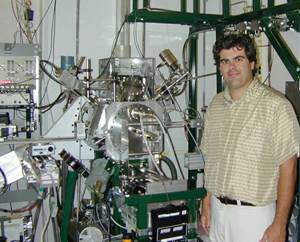
Aaron Fleet
with pulsed-laser deposition
vacuum apparatus in the
G3 experimental
station.
Dr. Aaron Fleet was recently awarded the first-ever Ph. D. Thesis Prize given by CHESS, the Cornell High Energy Synchrotron Source, for his thesis entitled “Time Resolved X-Ray Scattering during Strontium Titanate Homoepitaxy by Pulsed Laser Deposition.” The award was presented during the 2006 CHESS Users’ Meeting, held on June 13th at the Robert Purcell Community Center on the Cornell University north campus. Fleet completed his Ph. D. in Applied Physics in April 2005 at Cornell, studying with Professor Joel Brock.
“I have been so impressed by the quality of the Ph. D. thesis work going on at CHESS,” states Sol Gruner, director of CHESS, “that I thought that our user community would enjoy seeing the cream of the crop once a year.” With this rationale, 2006 was the first year CHESS solicited nominations for a Ph. D. Award from its user community. Eligible candidates must have received their degrees within the preceding 18 months and done a substantial amount of x-ray data collection for their thesis work at CHESS. The award winner receives a $1000 cash prize and an expense-paid trip to present his or her work at the annual CHESS Users’ Meeting.
Fleet was chosen from among six candidates who were put forward by their thesis advisors by way of detailed nomination letters. The judging was performed by four faculty-level scientists, from the CHESS user community, who volunteered to read each thesis and all nomination materials. Judges were chosen from multiple fields – biology and macromolecular crystallography, materials science, physics and one synchrotron expert - all but one from outside Cornell. Feedback from the judges showed the choice was difficult, considering a pool of outstanding thesis work and stellar graduate careers. One judge noted that for many of the candidates: “CHESS played a central and vital role in their research. It is highly unlikely that they would have the same theses if CHESS were not there for them. (The candidates all) produced high impact publications…” Another judge commented that Fleet’s thesis went beyond solid scientific results to include recommendations for future experiments at CHESS and new modes of data analysis.
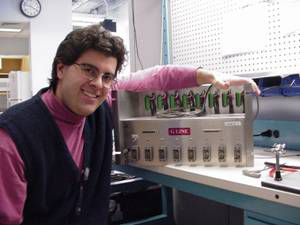
Aaron Fleet with the
first stepper motor drive unit he built.
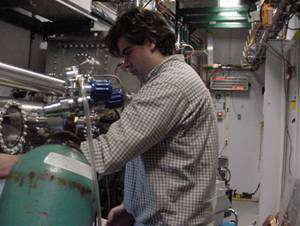
Aaron working to assemble motor drives in the
G-line optics room.
While a student, Fleet received his department's W.N. Findley Prize for the best paper by a graduate student for his article, "Observed Effects of a Changing Step-Edge Density on Thin Film Growth Dynamics", (Phys. Rev. Lett. 94, 036102, 2005). Like his thesis, the article is based on in-situ x-ray scattering measurements of the growth of SrTiO3 films using pulsed laser deposition (PLD). During PLD, a short, powerful laser pulse hits a target and creates a hot cloud of particles that rain down onto a clean heated substrate. X-ray scattering measurements record detailed information about the growing thin film – all without altering or interrupting the growth process. What Fleet noticed was that the x-ray intensity dropped quickly the moment the pulse of particles hit the surface, and then recovered over a characteristic time. He realized that this pattern indicates that growth occurs one layer at a time, and proposed that the energetic arriving particles were embedding themselves in, and mixing with, existing surface atoms of the top layer, rather than simply sticking where they landed and building up multiple layers at once. His work showed that time-resolved x-ray data can be used to distinguish between competing models of thin film growth and teach us how to grow high-quality films with superior magnetic (or other) properties.
“Aaron was here before the furniture or the walls,” Brock joked about introducing Fleet to CHESS in 2000, at a time when the experimental facilities in the recent G-line building addition were still pencil marks on paper. “I don’t think Aaron fully realized all that he was getting involved with…especially not emotionally.” His measurements were all performed at CHESS and Fleet, together with fellow graduate student Darren Dale, built all the x-ray, vacuum and laser equipment housed inside the G3 experimental station. In his nomination letter, Brock boasts that a number of other groups in Europe, Korea, and Japan have also put together synchrotron x-ray PLD systems. “Some have published time-resolved datasets qualitatively similar to those obtained by Aaron two to three years earlier. However, Aaron’s detailed analysis unveiled the underlying physics…”
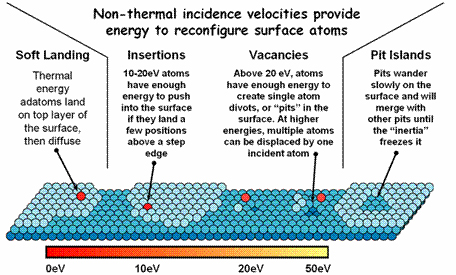
Model of atom insertions possible
during pulse laser
deposition thin-film growth.
Fleet received a combined B. Sc. degree in Physics and Economics in 1999 from the Colorado School of Mines in Golden, Colorado. He grew up in Golden and was the master brewer at the Golden City Brewery for three years. Fleet and his wife Christine (MS in Cornell's Food Science Department in August of 2001) now live in near Boston, Massachusetts. He currently works at the MIT Lincoln Laboratory as a scientist in the area of infrared detection.
About the competition one judge concluded: “I have to say that I truly enjoyed my reading of all submitted theses and nomination letters. They are the shining examples that Cornell and CHESS are truly education leaders in synchrotron-based science and applications.”
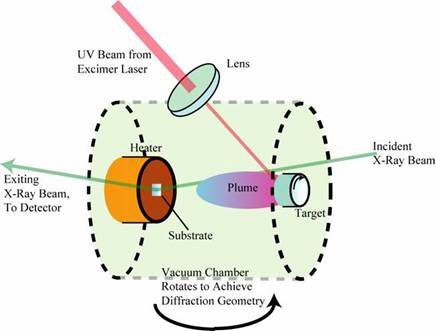
Schematic of x-ray measurements
simultaneous
with pulsed laser deposition.
About the competition one judge concluded: “I have to say that I truly enjoyed my reading of all submitted theses and nomination letters. They are the shining examples that Cornell and CHESS are truly education leaders in synchrotron-based science and applications.”
Related publications by Fleet:
Fleet, A., D. Dale, A.R. Woll, Y. Suzuki, and J.D. Brock, Multiple Time Scales in Diffraction Measurements of Diffusive Surface Relaxation. Physical Review Letters, 2006. 96(5): p. 055508.1-4.
Dale, D., A. Fleet, J.D. Brock, and Y. Suzuki, Dynamically tuning properties of epitaxial colossal magnetoresistance thin films. Applied Physics Letters, 2003. 82(21): p. 3725-27.
Dale, D., A. Fleet, J.D. Brock, and Y. Suzuki, The effect of changing epitaxial strain on colossal magnetoresistance thin films. Materials Research Society Symposium Proceedings, 2003. 751: p. 103.
Wang, H.-H., A. Fleet, J.D. Brock, D. Dale, and Y. Suzuki, Nearly strain-free heteroepitaxial system for fundamental studies of pulsed laser deposition: EuTiO3 on SrTiO3. Journal of Applied Physics, 2004. 96(9): p. 5324-28.
Fleet, A., D. Dale, Y. Suzuki, and J.D. Brock, Observed Effects of a Changing Step-Edge Density on Thin-Film Growth Dynamics. Physical Review Letters, 2005. 94: p. 036102.1-4.
Fleet, A., Time Resolved X-Ray Scattering During Strontium Titanate Homoepitaxy by Pulsed Laser Deposition. PhD Thesis, Applied Physics Cornell University, Ithaca, 2005. 1 - 185.
Recently submitted:
Dale, D., A. Fleet, J.D. Brock, and Y. Suzuki, X-ray scattering from real surfaces: discrete and continuous components of roughness. Submitted to Physical Review B, 2006.
